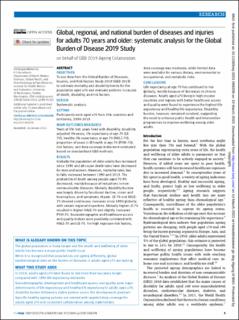| dc.description.abstract | Objectives To use data from the Global Burden of Diseases, Injuries, and Risk Factors Study 2019 (GBD 2019) to estimate mortality and disability trends for the population aged ≥70 and evaluate patterns in causes of death, disability, and risk factors. Design Systematic analysis. Setting Participants were aged ≥70 from 204 countries and territories, 1990-2019. Main outcomes measures Years of life lost, years lived with disability, disability adjusted life years, life expectancy at age 70 (LE-70), healthy life expectancy at age 70 (HALE-70), proportion of years in ill health at age 70 (PYIH-70), risk factors, and data coverage index were estimated based on standardised GBD methods. Results Globally the population of older adults has increased since 1990 and all cause death rates have decreased for men and women. However, mortality rates due to falls increased between 1990 and 2019. The probability of death among people aged 70-90 decreased, mainly because of reductions in non-communicable diseases. Globally disability burden was largely driven by functional decline, vision and hearing loss, and symptoms of pain. LE-70 and HALE-70 showed continuous increases since 1990 globally, with certain regional disparities. Globally higher LE-70 resulted in higher HALE-70 and slightly increased PYIH-70. Sociodemographic and healthcare access and quality indices were positively correlated with HALE-70 and LE-70. For high exposure risk factors, data coverage was moderate, while limited data were available for various dietary, environmental or occupational, and metabolic risks. Conclusions Life expectancy at age 70 has continued to rise globally, mostly because of decreases in chronic diseases. Adults aged ≥70 living in high income countries and regions with better healthcare access and quality were found to experience the highest life expectancy and healthy life expectancy. Disability burden, however, remained constant, suggesting the need to enhance public health and intervention programmes to improve wellbeing among older adults. | en_US |

